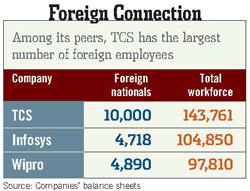
OUTSOURCING
Adding Up Foreign Numbers
Indian IT firms are now hiring more foreigners, but the numbers are low
VENKATESH G. AND DHANYA KRISHNAKUMAR
01 May 2009 |
 |
New Equation: The cost gap between Indian and US programmers has narrowed
(Pic by Sanjay Sakaria) |
Not many have heard of chuck grassley and Dick Durban, but a bill proposed by the two US senators is already changing the Indian IT industry’s recruitment strategy. The legislation seeks to bar Indian companies that have more than 50 per cent of their workforce on H1B and L1 visas, and will severely restrict banks and other financial institutions that heavily rely on the H1-B programme for augmenting their staff requirements. Quite apart from the fact that the Durban-Grassley bill will require employers to make a ‘good faith’ effort to hire Americans first, employers will also have to show that the H1B worker would not displace an American.
The move comes against the backdrop of a US labour department report that altogether 600,000 jobs were lost in the month of January, the biggest drop in the past three decades, taking the US unemployment rate to 16 per cent. Already, the US Citizenship and Immigration Services (USCIS) has said that it would only accept H1B visa applications within the terms and conditions imposed by the recently approved Employ American Workers Act.
Reacting to the bill, which could become a law as early as May, India’s largest software exporter, TCS, said it plans to double its foreign workforce from the current 10,000 over the next five years, while Infosys and Wipro expect to see foreigners make up 10-15 per cent of their total employee base in three-five years, from about 5 per cent at present (see ‘Foreign Connection’). Only, these numbers would still be minuscule compared to the 100,000 plus employee base of the Big Three, or the fact that they were each hiring 40,000-50,000 Indians annually when the market was doing better.
Meanwhile, TCS has entered into an agreement with the state of Ohio, by which it will get an incentive package worth $19 million (Rs 95 crore) in return for creating local jobs. “We are planning to recruit about 250 people in our Cincinnati development centre,” says N. Chandrasekaran, COO and executive director of TCS. He added that most of the recruitment will be from the university campuses in the region.
Similarly, HCL Technologies has announced that it is setting up a 400-strong development centre in North Carolina, investing $3.2 million over the next five years. “We selected North Carolina due to the state’s skilled workforce, strong educational network and its proximity to our customers,” says Vineet Nayar, CEO of HCL Technologies. This is a long-term agreement that has the potential to have some real impact, says Peter Schumacher, CEO of Value Leadership Group, an outsourcing advisory firm.
| If the bill is passed, the ability of Indian companies to leverage their cost advantage will be further challenged. “Hiring more overseas employees would put more pressure on the bottom lines of IT companies, which earn more than 60 per cent of their revenues from the US and are already bruised with clients demanding price cuts on contracts,” says C.S. Chandramouli, director for advisory services at Bangalore-based Zinnov Consulting. He debunks the protectionist agenda by pointing out that the top four Indian players accounted |
 |
| for only about 15 per cent of the 65,000 visa applications in 2008. |
“We haven’t used even one-third of what we applied for last year,” says Pratik Kumar, corporate vice-president and HR head of Wipro. “It’s a myth that we gobble up all the visas and, therefore, jobs.”
In the past three years, the 65,000 cap on H1B visa quotas was snapped up within a few hours of their application being allowed. But this year, according to the USCIS, only 45,000 applications for H1B visas have been filed till date. Indian IT companies have not aggressively applied for H1-Bs expecting a slowdown in outsourcing orders.
Industry body Nasscom feels strongly that the amendment isolates and unfairly targets Indian IT companies, severely restricting their level playing field. Contrary to popular belief that Indian IT firms take the majority of H1B visas, only 11 per cent of the total visas in 2008 were taken by the IT sector, Nasscom says.
Both Indian and foreign companies argue that there are a lot of misplaced notions with regard to Indians taking away American jobs. “Studies by firms such as McKinsey have shown that outsourcing has led to an economic advantage for the US,” says Sudhakar Ram, chairman and managing director of IT firm Mastek.
Driving Factors
Two factors are driving companies to push up their international headcount: protectionism, and Barack Obama’s socialist leanings — the US President was campaigning for jobs for Americans even before the meltdown. The effort of Indian companies to project the right image in the US happens to coincide with a time when less expensive skilled programmers are available due to huge layoffs. Now, the US government’s The Asset Relief Program (TARP) requires companies to explain the rationale behind shipping services-related jobs to other countries.
In March, members of the US Congress wrote to financial services firm JPMorgan Chase, asking it to explain its outsourcing plans to India. JPMorgan Chase got $25 billion TARP money and plans to increase outsourcing to India by 25 per cent, according to industry sources.
On the ground, too, things are changing. The average salary of a mid-level US programmer was $60,000 (Rs 30 lakh) annually in 2004, and has since tumbled to less than $20,000. “So, where is the cost difference when the cost of a programmer in the US has gone down significantly?” says the head of an outsourcing advisory firm, who does not wish to be named. Also, healthcare costs, which formed a big part of an employee’s salary, have been watered down, and in a lot of states in the US, employers have to provide for a minimum superannuation charge.
“If there are guys available in the US at lower salaries, they won’t want to send someone from here (India),” says Anu Parthasarathy, CEO of Global Executive Talent, a California-based senior executive search firm. She adds that compensation levels have come down in the US and risen in India. However, analysts are quick to point out that it is still less expensive to get work done from tier-II cities in India.
Indian firms need to establish a stronger onshore delivery capability, which can only be accomplished by engaging more local software engineers and business consultants, according to outsourcing advisor Schumacher. “On-site presence can be a key differentiator when competition for client retention increases,” agrees Nikhil Rajpal, principal of the Everest Group.
“It (the changed recruitment agenda) is a good move by Indian companies to look at globalising their delivery capabilities to create delivery capacity as a response to protectionism or otherwise,” agrees Sid Pai, MD of TPI India, a Bangalore-based IT advisory firm.
Parthasarathy sums it up best. “It is not like Indian companies are committed just to India either — it’s all about what is profitable.”
With inputs from Manashwi
Download Article Here
(Businessworld Issue Dated 05-11 May 2009)
An ABP Pvt Ltd Publication Copyright (C) All rights reserved. |